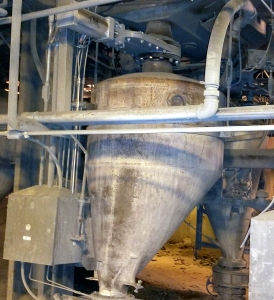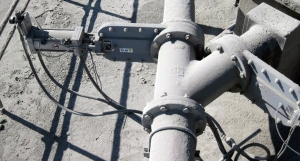
Client:
Quantity:
Size:
Application:
Many industries rely heavily on one another for certain raw materials and by-products. Kevin R. Peterson, Vortex Global, explains how this is especially apparent in West Virginia’s coal-fired energy, cement and oil/gas industries.
As featured in World Cement
by Kevin R. Peterson
West Virginia produces about 10% of US coal. When coal is burned to produce electricity, a by-product – coal ash – is created. Coal ash consists of fly ash and bottom ash. Fly ash is made up of the lightweight particles captured by the power plant’s electrostatic precipitators and baghouses, making fly ash a very fine powder. Bottom ash is collected at the bottom of boilers and is larger and coarser.
Coal-fired energy plants previously managed their coal ash by mixing the fly ash with bottom ash before conveying it through a pug mill mixer, where the mixture was blended with a small amount of water to control dust. The mixture was then disposed of at the landfill.
By volume, fly ash is the second-largest waste material in the US, behind only household trash. To better manage their fly ash, rather than disposing of the coal by-product as waste, many coal-fired energy plants upcycle it by supplying it to the cement industry.
Today, approximately 43% of the fly ash generated at US coal-fired energy plants is upcycled by the cement industry as a pozzolan. Pozzolans are siliceous and/or aluminous materials which, in a finely divided form and in the presence of water, react with calcium hydroxide at ordinary temperatures to produce cementitious compounds.
This clever use of by-products has many benefits, including:
- Improved workability in plastic concrete.
- Added strength and durability in hardened concrete.
- An additional revenue stream for coal-fired energy plants.
- A cost reduction for cement processors. When fly ash is added to cement blends, the amount of Portland cement used can be reduced. This also allows suppliers to offer cement at lower costs with similar or improved profit margins.
- Reduction in waste at the landfill, therefore improving our environment.
Note: Fly ash upcycling is only economically feasible if coal-fired energy plants and cement processors are located in close proximity to one another, for ease of purchase and transport.

Case study: coal-fired energy plant handling fly ash
Process
A coal-fired energy plant in West Virginia is conveying fly ash through pressure pots and into storage bins via a dense phase system. The plant was using disc valves to shut off flow at the inlet of each pressure pot.
Complications of the disc valves included:
- The sliding disc was subject to wear and abrasion from the material handled.
- Fly ash would pack between the disc and the seals upon valve closure, creating sealing and actuation issues.
- The disc valves required frequent maintenance, which resulted in expensive system shutdown.
For these reasons, conveyance through the pressure pots was an issue.
Solution
After analysing the application parameters, the Vortex Titan Pressure Valve was recommended. The valve was originally designed for conveying cement in dense phase pneumatic systems. It is also a perfect fit for this application; the reasons being:
- Abrasion resistance – The blade and seats are constructed from 440 C stainless steel (Rockwell hardness 60 C).
- Temperature resistance – In this application, fly ash is being handled at temperatures of 400 – 450°F (205 – 230°C). The Vortex Titan Pressure Valve is rated to handle material temperatures up to 660°F (350°C).
- High pressure conveying – In this application, fly ash is being conveyed at 25 – 35 psi (1.7 – 2.4 bar). The Vortex Titan Pressure Valve is rated to handle pressures up to 100 psi (6.8 bar).
- Gate closure/sealing design – Spring-loaded blade guides keep the blade in constant contact with the seat throughout the stroke of the blade. Upon gate closure, the leading edge of the blade lifts into an end seat to ensure a positive seal of pressure and material across the gate. The end seat features a displacement pocket to minimise material jamming and packing upon gate closure. Keeping the end seat clear of materials ensures positive gate closure.
- Air purge assembly – As standard, the Vortex Titan Pressure Valve is equipped with an air purge assembly. The air purge pressurises the bonnet area to minimise fine material build-up in the valve body. Because fly ash is an especially fine material, this feature is critical to preventing actuation issues.
Results
This coal-fired energy plant sourced one Vortex Titan Pressure Valve to test its performance in the unique application. That initial valve performed very well and over the past three years, the plant has continued to source Titan Pressure Valves as replacements to their disc valves. Over time, the plant will replace the balance of their disc valves with Vortex Titan Pressure Valves.

The local oil and gas industry
West Virginia is home to the 6000 ft (1830 m) deep Marcellus Shale, believed to contain 50 – 90 trillion ft3 (1.4 – 2.5 trillion m3) of natural gas. The rock formation spans 104 000 square miles (167 370 km2), stretching across southern New York, eastern Ohio, western Pennsylvania and most of West Virginia. It is believed to hold the largest volume of recoverable natural gas in the US. To recover oil and gas in this area, both vertical and horizontal wells are required.
Between coal-fired energy plants and oil/gas fields, West Virginia is a top US exporter of interstate electricity.
According to the West Virginia Department of Environmental Protection, in 2015, there were 56 675 oil and natural gas wells in the state, with 2273 of those being horizontal, hydraulically fractured wells.
In the oil and gas fields, fly ash is necessary to:
- Mix with earth and clay, in order to stabilise access roads.
- Serve as a base for drill pad sites.
- Solidify the drill cuttings and absorb liquids from the well drilling process.
Cement is required
Tons of cement are utilised in the drilling process. Cementing is an important part of groundwater protection. The process isolates groundwater from the inside of the well.
Cement mixtures are used to:
- Support the well casing.
- Protect the well casing from corrosion.
- Create a bond between the well casing and the earth.
- Isolate porous formations from the drilled zone.
- Quickly form a seal, in order to prevent blowouts.

Class F fly ash is used in well cementing, due to its low cost, high abundance and added resistance when attaching near groundwater. High carbon fly ash is avoided, due to its potential problems with gelation. Gelation is a mixture’s tendency to form into a gel, rather than a solid structure.
With almost 100 000 wells existing in West Virginia, there is continual need for fly ash and cement throughout the state. Though these industries are quite dissimilar, their processes have a close, very important relationship with one another. Equipment, like the valves manufactured by Vortex, play an important role in the efficient handling of raw materials.
Special thanks
Hareza Technical Sales, Inc. (HTS) is a manufacturers’ representative that specialises in the sales and marketing of quality process equipment and controls for industrial applications. Based in McMurray, Pennsylvania, USA, they service accounts in western Pennsylvania, northern Ohio, West Virginia, and the panhandle of Maryland. Industries served include cement, chemical, coal, food, glass, grain, pharmaceutical, and plastics, to name a few.
HTS was directly involved with the fly ash case study featured in this article.
About the author
Now in his 25th year with the company, Kevin R. Peterson is the Business Development Director for Vortex Global. A board member of the Industrial Minerals Association of North America, Kevin travels extensively to meet with customers and customer prospects. He has created and shared hundreds of case studies and written numerous articles that share the successes Vortex products have experienced with industries that handle and process dry bulk material.













